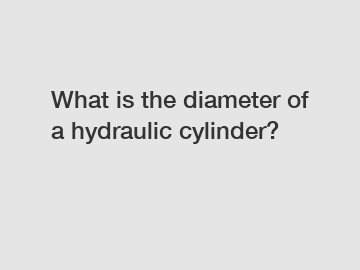What is the diameter of a hydraulic cylinder?
Hydraulic cylinders play a crucial role in various industrial applications, enabling the conversion of hydraulic energy into mechanical force. These cylindrical powerhouses may appear simple on the surface, but their engineering intricacies dictate their performance and effectiveness. Today, we delve into the fascinating world of hydraulic cylinders, specifically exploring their diameter and its significance in their operation.
Understanding Hydraulic Cylinders:
Hydraulic cylinders are fundamental components of hydraulic systems, providing linear motion through the transfer of fluid pressure. Consisting mainly of a cylindrical barrel, piston, and various seal components, they are designed to withstand immense forces under varying conditions. However, the diameter of these cylinders plays a vital role in determining their overall performance, efficiency, and reliability.

Finding the Right Fit: Diameter And Hydraulic Cylinders:
The diameter of a hydraulic cylinder is the measure of its size across the piston. While there is no fixed standard diameter, these cylinders come in a wide range of sizes to accommodate an array of applications. The specific diameter chosen depends on the load requirements, force output, stroke length, and other factors unique to each hydraulic system.
Balancing Power and Speed:
One critical aspect directly influenced by the diameter is the power output of the hydraulic cylinder. A larger diameter cylinder has a greater surface area, allowing it to generate higher forces. This increased force is essential when dealing with heavy loads or demanding applications such as lifting equipment or construction machinery.
However, it is also important to note that a larger diameter typically means slower speed. Due to the increased amount of fluid needed to fill the cylinder, the time required for the hydraulic system to complete a stroke may be longer. Hence, striking the right balance between force requirements and speed is crucial to ensure optimal efficiency without compromising performance.
Determining Cylinder Diameter:
Selecting the appropriate cylinder diameter demands a thorough understanding of the specific application requirements. Factors such as maximum force needed, operating conditions, available space, and system constraints must be considered. Consulting with hydraulic experts or manufacturers can facilitate the decision-making process, ensuring the cylinder diameter matches the intended purpose.
Size Matters: Factors Influencing Cylinder Diameter:
1. Load Capacity: One of the primary considerations is the weight or load that the hydraulic cylinder needs to handle. The cylinder must have an adequate diameter to generate the necessary force to lift or move the load effectively.
2. Compression and Extension Speed: The cylinder diameter can affect the speed at which it compresses or extends. For applications requiring precise and rapid movements, a smaller diameter cylinder may be appropriate. Contrastingly, applications that require a greater emphasis on power output may necessitate a larger diameter.
3. Space Constraints: Physical limitations, such as restricted space or installation conditions, can also impact the cylinder diameter. In cramped environments, it becomes crucial to choose a cylinder with a diameter that fits within the available space without sacrificing performance or safety.
4. System Stability: Hydraulic systems rely on a delicate balance between force, speed, and system stability. Selecting an oversized or undersized cylinder diameter can adversely affect the overall stability and generate unnecessary stress on the system. Thus, the diameter must be carefully calibrated to ensure optimal performance and longevity.
Conclusion:
While often overlooked, the diameter of a hydraulic cylinder is a vital consideration that can significantly impact its efficiency, power output, and performance. The selection of the appropriate cylinder diameter must consider multiple factors, such as load requirements, speed, space constraints, and system stability. A well-informed choice and consultation with hydraulic experts can enhance the overall functionality and reliability of the hydraulic system. By unlocking the power behind precision, an optimal hydraulic cylinder diameter can make all the difference in achieving superior performance in countless industries and applications.
Contact us to discuss your requirements of Automatic Gauge Control Servo Custom Hydraulic Cylinders, customized dual action cylinder solution, custom built cylinder. Our experienced sales team can help you identify the options that best suit your needs.


